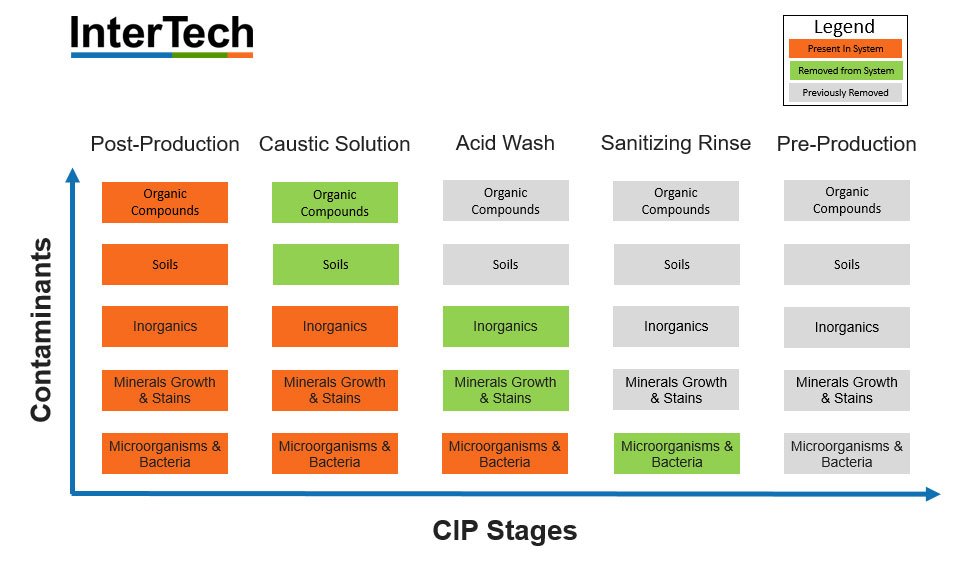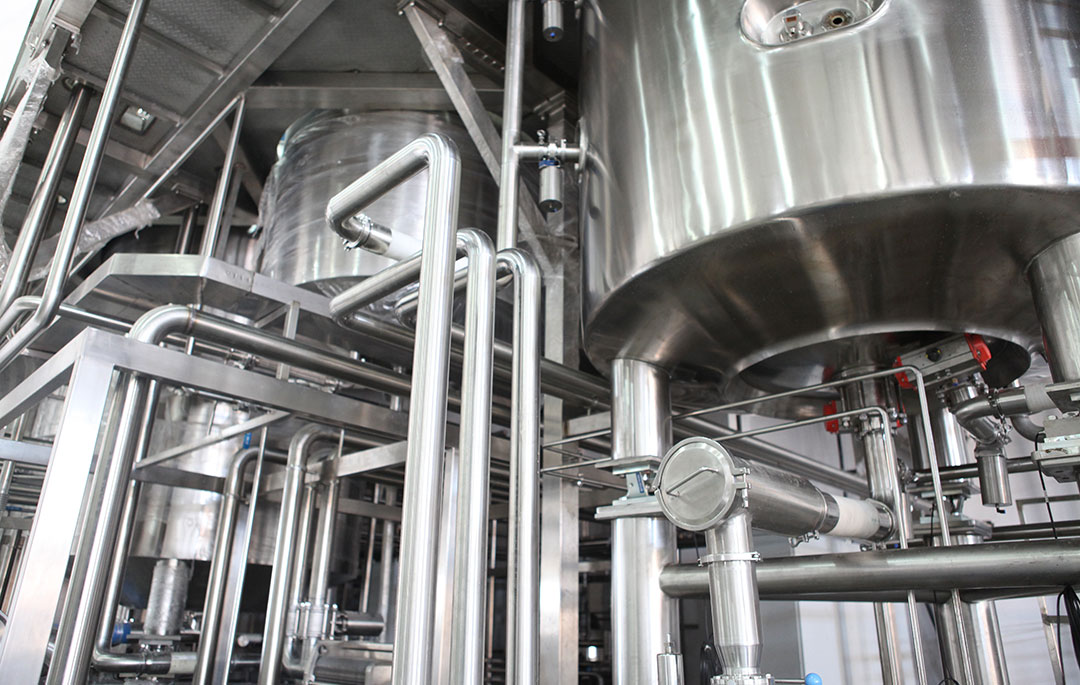(Updated 4/17/23)
Clean-In-Place, or CIP systems are the unsung heroes behind almost everything on a grocery store shelf. Many industries, from pharmaceuticals to cosmetics and food and beverage, rely on efficient and effective cleaning to ensure that customers know their products are safe.
All effective CIP systems operate on a combination of four simple principles: Temperature, Chemical Concentration, Mechanical Action, and Time.
In theory, these principles are simple, but as anyone who has struggled to get a stubborn stain out of a prized piece of clothing knows, cleaning can be a complicated subject. In this article, we will address the four CIP pillars, along with the best practices for each one.
Clean-In-Place Pillar 1: Temperature
It is important to note that CIP temperatures are monitored and tracked on the CIP circuit return header to ensure that the entire system is fully heated.
Typically CIP systems operate at approximately 140°F-180°F. That means the temperature on the source header coming out of the CIP is even higher. Temperature should be considered carefully when designing a system.
Moving more heat into a CIP system creates a higher temperature. Higher temperatures equal greater solubility, and therefore more cleaning power. So, is hotter better? Not necessarily…
This may be true from the perspective of some application sciences, but as a system approaches it’s boiling point, other issues arise. Cavitation from essentially uncontrolled boiling can occur at pump intakes, making the system more hazardous to operators.
Boiling is a function of pressure. It is well known that water will turn into steam in an open pot at atmospheric pressure when the temperature reaches 212°F. But, water at 80psi remains a liquid all the way up to a temperature of 312°F.
If pressure decreases in the circuit, this water will flash into steam causing hammer in your piping system. Unintended phase changes between steam and condensate also create a carbonic acid that attacks the pipe wall and decreases the useful life of a pipe.
Higher temperatures mean the system contains more internal energy, enthalpy and entropy. Let’s go back to that liquid under pressure at 80psi and at 312°F. If the piping system carrying this develops a hole or leak, the liquid can escape at atmospheric pressure.
The water instantly changes to a superheat steam with even higher internal energy (entropy), which can cause damage to the surrounding equipment, structures and personnel. Injuries from steam at a given temperature are more severe than injuries from water at the same temperature because the internal energy of steam is higher.
Obtaining and sustaining higher temperatures makes the CIP process more expensive and fundamentally more dangerous.
At InterTech, we manage the clean-in-place system design by creating only enough heat to properly clean the system.
Clean-In-Place Pillar 2: Chemical Concentration
Chemical concentration is typically tracked with a combination of metered dosing and conductivity sensors. By mixing the chemical in a closed loop, CIP systems can ensure that the solution reaches and maintains a concentration before starting cycle timers related to washing the system.
Conductivity is also critical to ensure chemicals are removed from the system before the rinse step completes its cycle. Some substances don’t readily dissolve, even under near-boiling conditions. This is why proper chemical selection is critical when designing CIP systems.
There is no one-size-fits-all approach. In our everyday lives, soap is used to wash away common dirt and grime, but commercial CIP systems typically use something much more powerful to break down soils.
Caustic solutions followed by a water rinse break down most organic compounds or soils. Acid washes with a water rinse are done after the caustic cycle to remove inorganics, minerals and stains. Sanitation cycles follow the caustic and acid cycles.

There are hot water sanitation cycles that typically run between 180°F-200°F. There are also chemical sanitizers that can run at room temperature. But, a chemical sanitizer is another chemical that has to be purchased, stored and managed, adding additional expense.
At InterTech, we work as an integrated team with your chemical supplier to set up a clean-in-place system that works for your application.
CIP Pillar 3: Mechanical Action
Although a good soak can loosen many soils, merely allowing components to contact a hot CIP solution is rarely effective enough. Mechanical action or scrubbing is needed to ensure that soils are physically removed from surfaces.
Usually, this takes the form of turbulent flow in piping along with cascading in vessels. The details of turbulent flow are beyond the scope of this article, but a velocity of at least five feet per second ensures that effective scrubbing action occurs.
Another option for vessels and other areas that aren’t flooded during cleaning is impingement, which is impacting areas with jets of water. This is where specially engineered spray devices like spray balls can ensure even hard-to-reach areas are effectively cleaned.
Tracking mechanical action is measured indirectly by monitoring flow rates that are designed to produce the correct velocity for the given pipe size and length.
Proper pump design and calibration and selection of accurate flow instrumentation is vital to a proper clean-in-place design. At InterTech, we ensure these details are correct for your system.
ClP Pillar 4: Time
Time is the final pillar in the CIP process. Even a perfectly designed system will yield poor results if not given time to operate. Of course, excessive time is costly. This is another major reason why one-size-fits-all solutions are not effective.
Unlike other factors, time is almost always determined in the field empirically by timing how long it takes to reach the particular CIP goal. A good rule is to have approximately each rinse or CIP solution travel through the complete path of the circuit at least five times to ensure proper cleaning before moving onto the next step.
We look forward to helping you design the best clean-in-place system for your application. Please reach out to us when the time is right.

Let us show you how InterTech will improve your operating efficiencies and increase your profitability
InterTech brings clients value by performing plant engineering services with integrity, skill and efficiency. Our specialty is working within existing facilities to optimize line design for space and efficiency.


0 Comments